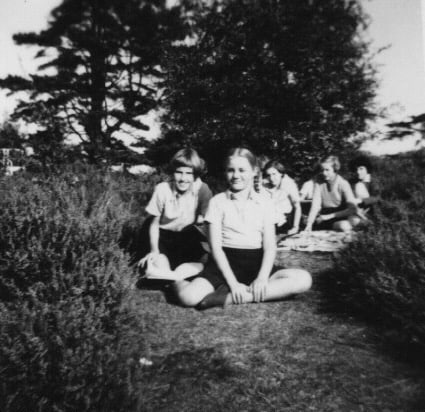CLAREMONT SCHOOL
Norwood, Class of 1959
Susan Walton (Hodge)
Whilst Susan was a day girl, she remembers cycling to school with her sister Jill (Norwood, Class of 1956) from Milbourne Lane in Claygate. Susan shares a tapestry of fun memories including a day in the life of a Claremont boarder:

“‘I began in September 1951 (my sister Jill had been a pupil from 1950) but we then went to live in Singapore and Malaya, returning in January 1953 as boarders. Although boarding schools still exist, they are so different (and luxurious) now from what we experienced. Claremont was a very small school in those post-war years – there must only have been about 16 boarders in our year (in the Lower 5, we were all in one big dormitory on the top floor – that room has been divided into 2 classrooms these days), with another 8-10 day girls. At first I was very home-sick and found it difficult to adjust to boarding school life, but when thinking about it today, I believe the rigid daily and weekly routines helped to make it bearable.”
“The strict routines of boarding life which shaped our lives:
The bells
Wake up was at 7.00 a.m. (8.00 on Sundays) followed by Quiet Time (7.30) to read the Christian Science Lesson for each day; breakfast at 8.00. Saturday mornings divided into hourly chunks for mending/shoe-cleaning and homework.
Sunday mornings
Laundry (we were provided with one clean sheet each week – we put the old top sheet to the bottom and sent the bottom sheet to the Laundry), followed by Letter-writing to parents and then Sunday School held in the Main Hall.
The meals
Tea at 4.00 pm when the day-girls had left and Supper at 7.00, except on Wednesdays and Sundays when it was High Tea at 5.30 and then ‘Last Laps’ before we went to bed. Each table in the dining-room was for 10 and therefore there were 10 different cakes called ‘fancies’ on each table for Sunday High Tea. Before meals you queued in the hall and, on your way in, collected your napkin in a proper napkin ring from your pigeon hole. For lunches and dinners (but not Tea) either a Prefect or a member of staff would sit on each table. We were taught ‘manners’ (i.e. never to ask for the salt as your neighbour should have noticed if you need it), and to make polite conversations. For some meals everyone had to speak French, which limited the conversation.
Christmas lunch
For Christmas lunch, we were waited on by the Staff who would sing, ‘The Christmas Pud in Hand bear we, bedecked with holly and red berry’ as they brought in the food.
Sweet treats
For Break each day there were trays of iced buns or Chelsea buns. Sweets were only allowed at weekends and kept locked in a cupboard. When the cupboard was unlocked, each girl could choose 5 from her own sweet tin.
The times we had to be outside in the fresh air whatever the weather
Walking round the drive after breakfast every day; after lunch in the grounds on Saturdays and Sundays. The games we played on the Mound, hiding in the rhododendrons on Saturdays and Sundays. The chief game was a version of Hide and Seek called Tallywags which ended when someone called Olly-olly-umfrey. The thrill of having the freedom of the grounds to roam in. Ice-skating on the frozen lake (now part of the National Trust grounds). The cork tree given to Queen Victoria.
Random memories
The difficulty of getting warm in winter – frost sometimes on the inside of the windows in the dorms, chilblains on toes and fingers, we huddled by gas fires in the Common Rooms. Our trunks arriving in Carter-Patterson vans and stored each term in Clive’s Bath in the basement. Being allowed to use the lift for 6 weeks when I broke my leg when jumping off The Log. The sunken marble bath in the bathroom near the Japanese Dorm. The exquisite paintings on the wall of the Japanese Dorm. Sunday Reading in the drawing-room in the afternoons when Miss McAfee read aloud from a work of fiction, (she chose Rosemary Sutcliffe’s Eagle of the Ninth when it was first published), followed by Hymn-singing when she played the grand piano (I think attendance was not compulsory?). Miss Jaques who taught French learning to drive in a bubble-car going round and round the Drive.”















